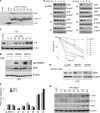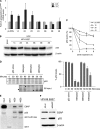Comparative analysis of transforming properties of E6 and E7 from different beta human papillomavirus types
- PMID: 22171257
- PMCID: PMC3302372
- DOI: 10.1128/JVI.06579-11
Comparative analysis of transforming properties of E6 and E7 from different beta human papillomavirus types
Abstract
The cutaneous beta human papillomavirus (beta HPV) types appear to be involved in skin carcinogenesis. However, only a few beta HPVs have been investigated so far. Here, we compared the properties of E6 and E7 oncoproteins from six uncharacterized beta HPVs (14, 22, 23, 24, 36, 49). Only HPV49 E6 and E7 immortalized primary human keratinocytes and efficiently deregulated the p53 and pRb pathways. Furthermore, HPV49 E6, similarly to E6 from the oncogenic HPV16, promoted p53 degradation.
Figures




References
-
- Andersson K, et al. 2008. Seroreactivity to cutaneous human papillomaviruses among patients with nonmelanoma skin cancer or benign skin lesions. Cancer Epidemiol. Biomarkers Prev. 17:189–195 - PubMed
-
- Bouwes Bavinck JN, et al. 2010. Multicenter study of the association between betapapillomavirus infection and cutaneous squamous cell carcinoma. Cancer Res. 70:9777–9786 - PubMed
Publication types
MeSH terms
Substances
Grants and funding
LinkOut - more resources
Full Text Sources
Research Materials
Miscellaneous

